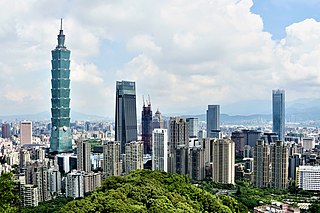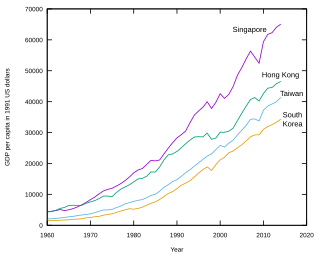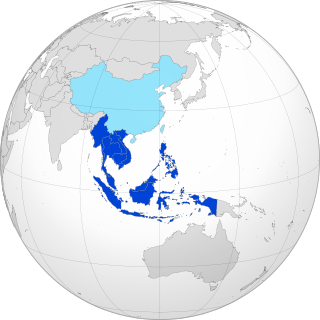
The economy of Indonesia is a mixed economy with dirigiste characteristics, and it is one of the emerging market economies in the world and the largest in Southeast Asia. As an upper-middle income country and member of the G20, Indonesia is classified as a newly industrialized country. Estimated at over 21 quadrillion rupiah in 2023, it is the 16th largest economy in the world by nominal GDP and the 7th largest in terms of GDP (PPP). Indonesia's internet economy reached US$77 billion in 2022, and is expected to cross the US$130 billion mark by 2025. Indonesia depends on the domestic market and government budget spending and its ownership of state-owned enterprises. The administration of prices of a range of basic goods also plays a significant role in Indonesia's market economy. However, since the 1990s, the majority of the economy has been controlled by individual Indonesians and foreign companies.

The economy of the Philippines is an emerging market, and considered as a newly industrialized country in the Asia-Pacific region. In 2023, the Philippine economy is estimated to be at ₱25.27 trillion, making it the world's 34th largest by nominal GDP and 14th largest in Asia according to the International Monetary Fund.

Southeast Asia is the geographical south-eastern region of Asia, consisting of the regions that are situated south of China, east of the Indian subcontinent, and north-west of mainland Australia which is part of Oceania. Southeast Asia is bordered to the north by East Asia, to the west by South Asia and the Bay of Bengal, to the east by Oceania and the Pacific Ocean, and to the south by Australia and the Indian Ocean. Apart from the British Indian Ocean Territory and two out of 26 atolls of Maldives in South Asia, Maritime Southeast Asia is the only other subregion of Asia that lies partly within the Southern Hemisphere. Mainland Southeast Asia is entirely in the Northern Hemisphere. East Timor and the southern portion of Indonesia are the parts of Southeast Asia that lie south of the Equator.

The economy of Taiwan is a highly developed free-market economy. It is the 8th largest in Asia and 20th-largest in the world by purchasing power parity, allowing Taiwan to be included in the advanced economies group by the International Monetary Fund. Taiwan is notable for its rapid economic development from an agriculture-based society to an industrialised, high-income country. This economic growth has been described as the Taiwan Miracle. It is gauged in the high-income economies group by the World Bank. Taiwan is one of the most technologically advanced computer microchip and high-tech electronics industries makers in the world.

The Four Asian Tigers are the developed East Asian economies of Hong Kong, Singapore, South Korea, and Taiwan. Between the early 1950s and 1990s, they underwent rapid industrialization and maintained exceptionally high growth rates of more than 7 percent a year.

The bamboo curtain is a Cold War political demarcation between the communist states of East Asia, particularly the People's Republic of China, and the capitalist states of East, South, and Southeast Asia. To the north and northwest lay the communist states of China, the Soviet Union, North Vietnam, North Korea, and the Mongolian People's Republic. To the south and east lay the capitalist and non-communist countries of India, Pakistan, Japan, Indonesia, Malaysia, Singapore, the Philippines, Thailand, Taiwan, South Korea, British Hong Kong, and Portuguese Macau. Before the Indochina Wars the non-communist bloc included French Indochina and its successor states South Vietnam, Laos, and Cambodia. However, after the wars the new countries of Vietnam, Laos, and Democratic Kampuchea became communist states. In particular, following the Korean War, the Korean Demilitarized Zone became an important symbol of this Asian division.

The 1997 Asian financial crisis was a period of financial crisis that gripped much of East and Southeast Asia during the late 1990s. The crisis began in Thailand in July 1997 before spreading to several other countries with a ripple effect, raising fears of a worldwide economic meltdown due to financial contagion. However, the recovery in 1998–1999 was rapid, and worries of a meltdown quickly subsided.

The economy of Asia comprises about 4.7 billion people living in 50 different nations. Asia is the fastest growing economic region, as well as the largest continental economy by both GDP Nominal and PPP in the world. Moreover, Asia is the site of some of the world's longest modern economic booms.
An emerging market is a market that has some characteristics of a developed market, but does not fully meet its standards. This includes markets that may become developed markets in the future or were in the past. The term "frontier market" is used for developing countries with smaller, riskier, or more illiquid capital markets than "emerging". As of 2006, the economies of China and India are considered to be the largest emerging markets. According to The Economist, many people find the term outdated, but no new term has gained traction. Emerging market hedge fund capital reached a record new level in the first quarter of 2011 of $121 billion. Emerging market economies’ share of global PPP-adjusted GDP has risen from 27 percent in 1960 to around 53 percent by 2013. The ten largest emerging economies by nominal GDP are 5 of the 10 BRICS countries along with Indonesia, Mexico, Poland, South Korea, and Turkey.

A tiger economy is the economy of a country which undergoes rapid economic growth, usually accompanied by an increase in the standard of living. The term was originally used for the Four Asian Tigers as tigers are important in Asian symbolism, which also inspired the Tiger Cub Economies. The Asian Tigers also inspired other economies later on; the Anatolian Tigers in the 1980s, the Gulf Tiger (Dubai) in the 1990s, the Celtic Tiger in 1995–2000, the Baltic tigers in 2000–2007, and the Tatra Tiger (Slovakia) in 2002–2007.

Nanyang is the Chinese term for the warmer and fertile geographical region along the southern coastal regions of China and beyond, otherwise known as the 'South Sea' or Southeast Asia. The term came into common usage in self-reference to the large ethnic Chinese migrant population in Southeast Asia, and is contrasted with Xiyang, which refers to the Western world, Dongyang, which refers to Japan. The Chinese press regularly uses the term to refer to the region stretching from Yunnan Province to Singapore and from Myanmar (Burma) to Vietnam ; in addition, the term also refers to Brunei, East Malaysia, East Timor, Indonesia and the Philippines in the region it encompasses.
Economic miracle is an informal economic term for a period of dramatic economic development that is entirely unexpected or unexpectedly strong. Economic miracles have occurred in the recent histories of a number of countries, often those undergoing an economic boom or described as a tiger economy.

The Asian Century is the projected 21st-century dominance of Asian politics and culture, assuming certain demographic and economic trends persist. The concept of Asian Century parallels the characterisation of the 19th century as Britain's Imperial Century, and the 20th century as the American Century.
Developmental state, or hard state, is a term used by international political economy scholars to refer to the phenomenon of state-led macroeconomic planning in East Asia in the late 20th century. In this model of capitalism, the state has more independent, or autonomous, political power, as well as more control over the economy. A developmental state is characterized by having strong state intervention, as well as extensive regulation and planning. The term has subsequently been used to describe countries outside East Asia that satisfy the criteria of a developmental state. The developmental state is sometimes contrasted with a predatory state or weak state.
The East Asian model, pioneered by Japan, is a plan for economic growth whereby the government invests in certain sectors of the economy in order to stimulate the growth of specific industries in the private sector. It generally refers to the model of development pursued in East Asian economies such as Japan, South Korea, Hong Kong and Taiwan. It has also been used by some to describe the contemporary economic system in Mainland China after Deng Xiaoping's economic reforms during the late 1970s and the current economic system of Vietnam after its Đổi Mới policy was implemented in 1986. Generally, as a country becomes more developed, the most common employment industry transitions from agriculture to manufacturing, and then to services.

The ASEAN–China Free Trade Area (ACFTA) is a free-trade area among the ten member states of the Association of Southeast Asian Nations (ASEAN) and the People's Republic of China.

Bamboo network and Chinese Commonwealth are terms used to conceptualize connections between businesses operated by the Overseas Chinese community in Southeast Asia. The Overseas Chinese business networks constitute the single most dominant private business groups outside of East Asia. It links the Overseas Chinese business community of Southeast Asia, namely Malaysia, Indonesia, Singapore, Thailand, Vietnam, the Philippines, and Myanmar with the economies of Greater China. The Overseas Chinese play a pivotal role in Southeast Asia's business sector as they dominate Southeast Asia's economy today and form the economic elite across all the major Southeast Asian countries. The Chinese have been an economically powerful and prosperous minority for centuries and today exert a powerful economic influence throughout the region. Overseas Chinese wield tremendous economic clout over their indigenous Southeast Asian majority counterparts and play a critical role in maintaining the regions aggregate economic vitality and prosperity. Since the turn of the 21st century, postcolonial Southeast Asia has now become an important pillar of the Overseas Chinese economy as the bamboo network represents an important symbol of adumbrating itself as an extended international economic outpost of Greater China.

The Regional Comprehensive Economic Partnership is a free trade agreement among the Asia-Pacific nations of Australia, Brunei, Cambodia, China, Indonesia, Japan, South Korea, Laos, Malaysia, Myanmar, New Zealand, the Philippines, Singapore, Thailand, and Vietnam. The 15 member countries account for about 30% of the world's population and 30% of global GDP, making it the largest trade bloc in history. Signed in November 2020, RCEP is the first free trade agreement among the largest economies in Asia, including China, Indonesia, Japan, and South Korea.
The East Asian Bureau of Economic Research (EABER) is a forum for economic research and analysis of the major issues facing the economies of East Asia.

Since its formation in 1963, Malaysia's economic performance has been one of Asia's best. Real gross domestic product (GDP) grew by an average of 6.5% per year from 1957 to 2005. Performance peaked in the early 1980s through the mid-1990s, as the economy experienced sustained rapid growth averaging almost 8% annually. Malaysia's economy was greatly impacted by the 1997 Asian financial crisis, but recovered.















